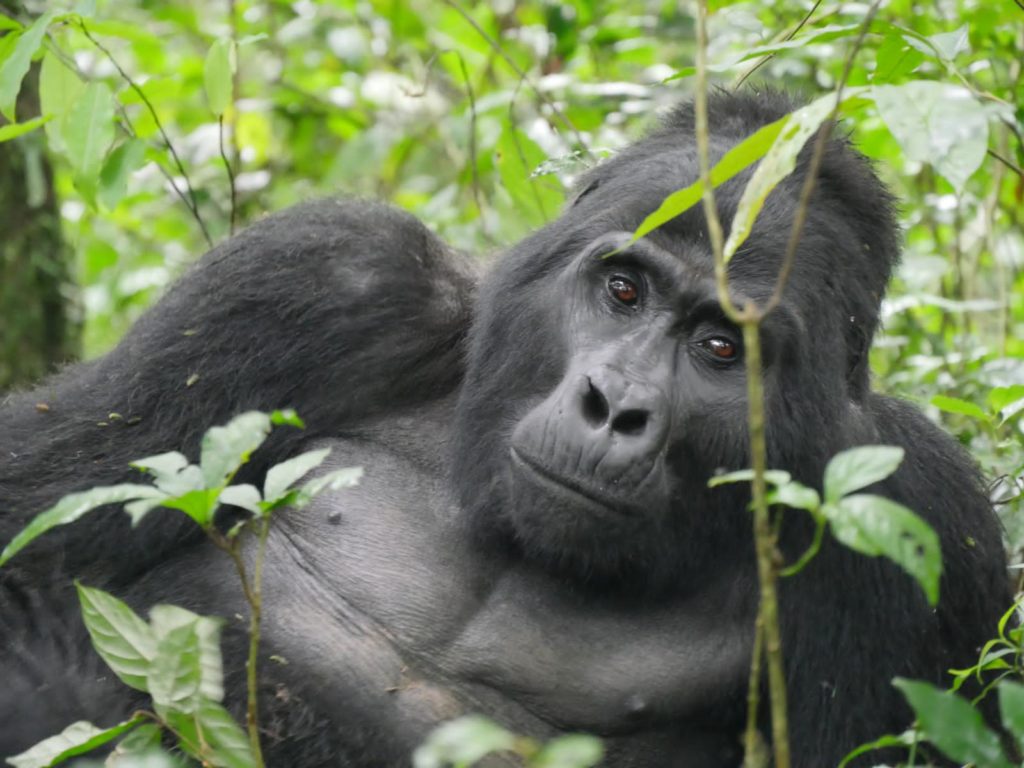Mountain Gorillas are so rare, why?
There are so few mountain gorillas remaining. This is due to several reasons. First, the size of their habitat is rather small. Indeed, Bwindi forest is only 33 km sq. The Virunga volcanoes is 450 km sq. Highly populated rural areas of 200-400 people per sq km surround these parks. Here, people make their living through subsistence farming.
Mostly habitat destruction, poaching and disease threaten the gorillas. People illegally harvesting trees degrade the forests. Other forest products too are destructive. And this subsequently reduces suitability for the gorillas.
In fact, people living around Bwindi and the Virungas do not eat primates. However poachers set snares to capture forest antelopes. These snares often catch the gorillas instead. In recent years, poaching for the pet trade is on the increase.
The gorillas get diseases, either respiratory or parasitic. People may transmit these diseases. Close contact with the gorillas increases the risk of disease transmission. The guidelines for tourists are of course designed to protect the gorillas. But also, you from getting sick. So please follow them.
How many mountain gorillas are there?
There are only about 850 Mountain gorillas. And they are critically endangered. Mountain gorillas are found in only 2 small populations. These are namely the Virunga volcanoes of Uganda, Rwanda and Congo. And in Bwindi impenetrable national park.
Bwindi has approximately 400 gorillas. The rest are found in the Virunga Volcanoes.
The change in the population of gorillas is regularly monitored. This is through conducting censuses of the whole park. It is done every after about 5 years. The parks are intensively searched for signs of the gorillas. Then, group sizes and composition are estimated by basing on the number of nests per group. However in 2006, genetic analysis of the gorilla feces were used to confirm the identity of groups and individuals.
Social interactions of Mountain Gorillas
Gorillas are very social. Indeed all group members coordinate their daily activities. A typical day consists of several hours feeding and moving through the forest. They rest for a few hours. Usually interactions among individuals are peaceful. Occasionally conflicts arise over feeding spots. During this time, individuals give aggressive ‘cough grant’ vocalizations. They scream and even fight.
Silver-backs are dominant over all other members including the adults in the group. Also, dominance exists among adult females. And among the silver-backs in multi-male groups. Moreover, males may compete for access to females. This indeed occurs within multi male groups as well as between groups.
Inter-group encounters occur about once a month. This is the only opportunity for females to transfer between social units. It is also the time for males to out compete their opponents. In turn, they become more impressive in order to attract females.
Friendly interactions among gorillas consist of resting together and grooming infants. Juveniles have endless energy for playing.
The Family life of Mountain Gorillas
A typical group of gorillas consists of about 10 members. The dominant silver-back, several adult females and the immature offspring of various ages. However, there can be a lot of variation. Group size may range from 2 to 30 or more individuals. Groups may contain more than 2 silver-backs. In multi male groups, the silverbacks are usually related as brothers, half brothers or father and son.
When gorillas reach maturity, they typically but not always, leave the group in which they were born. As a matter of fact, females will transfer directly to another group. This is when they are 6-10 years. Males follow one of two strategies to become the leader of a group. Either remain in the group and try to take over. Alternatively, emigrate to become a solitary male and eventually form a new group. All male gorillas become silverbacks at the age of 14 years. But not all males become group leaders.
Reproduction of Mountain Gorillas
Females have their first offspring at about age 10. Gestation lasts 8.5 months. About 1 in 3 babies born do not survive beyond the age of three. Gorillas may live into their early 40s. Each female has only 4 off springs that survive to adulthood. This is because females have babies every 4-5 years. Silver-backs are dominant for 10 or more years. They sire 5, 10 or more offspring. Subordinate silver-backs in multi male groups sometimes sire offspring.
Diet among Mountain Gorillas
Gorillas are vegetarians. Their diet consists of leaves, stems and fruit. These are from the various vegetation in the forest. Most people are surprised that gorillas do not eat meat. Nonetheless, with the exception of the occasional ant or termite.
Mountain Gorillas eat mainly vegetables
Why are gorillas so big and strong? Yet do not eat meat? Imagine spending 5-6 hours a day eating only salad or vegetables. That is how they get enough to eat. Gorillas’ stomachs are so big. Not because they are fat. They digest all that vegetation.
The diet of mountain gorillas varies quite a lot. This depends on what is available. For example, some plants are quite common in the low altitude area of Buhoma. However these are rare or absent from the higher altitude areas of the park for instance in Ruhija. The gorillas also select foods that are high in proteins and carbohydrates but low in fiber.
Bwindi gorillas enjoy fruit and they will not hesitate to climb 20 meters or more to eat it. However, it is available at only certain times of the year. Also as altitude increases, fruit availability declines. So the gorillas in Buhoma have more fruit than those in Ruhija. The mountain gorillas in Virunga Vocanoes consume almost no fruit at all.
Ranging
In Bwindi, gorillas travel about 1 km a day. How far they move depends on the amount of available food. They travel further when they are searching for fruit. However, they move less while eating only vegetation. Sometimes, they may also travel a lot. This occurs when they have had an encounter with another group. One silver-back may be trying to move his group away from the other one.
Each group occupies a home range of about 10-30 square km. The home range of neighboring groups overlaps with one another.
Why can we see mountain gorillas so well if they are wild?
Gorillas are naturally afraid of humans. They will usually flee. They can aggressively charge if people get too close to them. Gorillas that are visited by people have undergone ‘habituation’. With this process, gorillas go through daily contact with humans. Thus gorillas have slowly lost their fear of humans. Therefore, they have learnt to view them as neutral beings in their environment.
Mountain Gorilla habituation
Habituating a group of gorillas usually takes about 2 years. The guidelines established for tourist visits have been developed. This is to respect the special relationship that exists through habituation. The gorillas briefly letting us into their world.
Conservation activities
The Uganda Wildlife Authority and conservation organizations work to protect the gorillas. This is through a multi- approach as listed below.
Law enforcement
Park rangers routinely patrol the park to reduce illegal activities. Furthermore, they cut snares and catch poachers.
Eco-Tourism
The gorilla permit fees generate revenue. This helps to protect the parks. Additional employment is created for the local people. Thirdly, people work as porters and artisans. Others work as guides and in restaurants in the lodges.
Community development
Several projects aim to improve the lives of the local people. This is through improving agricultural practices. More so, in the development of small businesses. Assistance is also given to the community. This is done through the construction of schools, roads and health clinics.
Research and monitoring
To conserve the gorillas, we must understand their ecological patterns. But also their behavioral patterns. We must also have information. For example, to know how the gorilla population and their habitats change over time.
Veterinary medicine and Public health
Veterinarians are always on standby to remove snares. In like manner, they treat the gorillas for respiratory illnesses. They also monitor gorilla health. The improvement in public health practices benefits the communities. And of course the rare mountain gorillas.
Information source: Uganda Wildlife Authority



